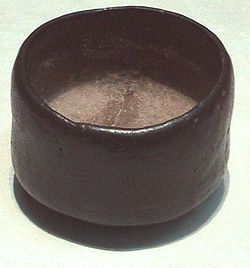- Chawan
-
A chawan (茶碗) or tea bowl is a bowl used for preparing and drinking matcha (powdered green tea) in the Japanese tea ceremony. There are many types of chawan used in tea ceremony, and the choice of their use depends upon many considerations.
In Japan, "chawan" also is the standard term for bowls for rice. If it is necessary to distinguish between them, bowls for rice are called gohan jawan, while the those for use in tea ceremony are called matchawan. The handle-less cups used for drinking regular steeped tea are generally referred to as yunomi (literally, cups for hot water), while the small porcelain cups used for fine-quality steeped green tea are often distinguished as senchawan. When the word chawan stands alone, it is normally prefixed with the honorific o-.
Contents
History
The first chawan came from China.
Styles and classification
 Two modern "thin tea" bowls.
Two modern "thin tea" bowls.
Chawan are classified according to their place of origin or manufacture, colour, shape, materials and other characteristics. More than one classification may apply to a given bowl.
Most chawan are bowl-shaped, but shapes vary widely. There are names for each general shape, within which there may be many variations. Common shapes include cylindrical, flat and round. Cylindrical bowls are called tsutsu-jawan, while shallow bowls are called hira-jawan.
Chawan are also classified according to the type of tea that will be served in them: bowls for "thin tea" (usucha) are referred to as usuchawan, and those for and "thick tea" (koicha), koichawan.
Karamono
Karamono (唐物) refers generally to styles of chawan that originated in China. These bowls were designed for drinking tea. Note that in all cases, the names are Japanese.
- Tenmoku (天目)
- Haikatsugi
- Yohen
- Kensan
- Yuteki
- Taihisan
- Seiji (青磁, celadon-ware)
- Hakuji (白磁, white porcelain)
- Sometsuki (blue and white porcelain)
Kōraimono
Kōraimono (高麗物) refers generally to styles of chawan that originated in Korea. Korean chawan were originally rice bowls that were adapted for tea when they entered Japan, much like Chinese oil bottles became tea caddies. Korean bowls were a favourite of Sen no Rikyu because of their rough simplicity.[1]
- Iji
- Mishima
- Kaki-no-heta
- Kinsan
- Ido
- Gōki
- Goshō Maru
- Totoya
- Katade Komogai
- Kohiki
- Amamori
- Hagame
- Sōhaku
- Gohon
- Tamagote
- Sōba
- Unkaku
- Wari-kodai
- Iraho
Wamono
Wamono (和物) can refer to anything that is traditionally Japanese, or made in Japan. In the case of chawan, it refers to styles that were developed in Japan.
Wamono chawan can be further divided by location and by kiln:
Provincial
- Karatsu
- Asahi
- Oku-gorai
- Iga
- Hagi
- Seto (瀬戸)
- Setoguro (瀬戸黒)
- Izumo
- Shigaraki
- Oribe (織部)
- Shonzui
- Genpin
- Shino (志野)
- Satsuma
Raku (kiln)
Raku is also known as raku-yaki (楽焼).
- Chojiro I
- Kōetsu
- Nonko
References
- ^ Sadler, A.L. Cha-No-Yu: The Japanese Tea Ceremony. Tokyo: Tuttle, 1962, 67.
See also
- List of Japanese tea ceremony utensils
External links
Categories:- Japanese tea ceremony
- Japanese pottery
- Teaware
- Tenmoku (天目)
Wikimedia Foundation. 2010.



